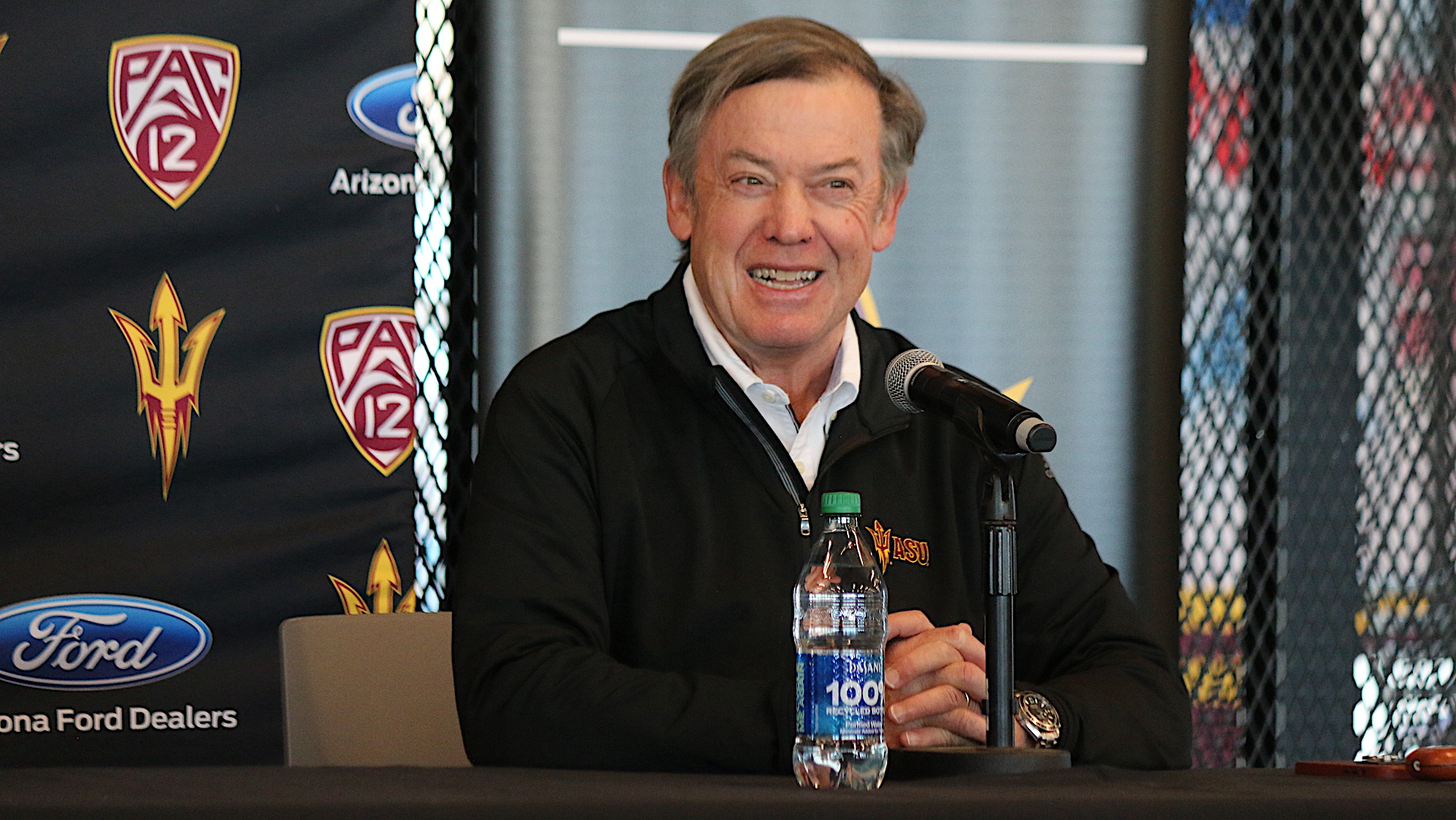It takes a lot to kill a pillar of college sports; in this case, it took 10 schools
No single individual is to blame for the death of the Pac-12. Rather, it was a conspiracy of the witless and the unwitting.
The two commissioners, Larry Scott and George Kliavkoff, have plenty of blood on their hands; both made a series of gross strategic miscalculations. If we’re identifying suspects, they are the first to be rounded up and cuffed.
But as in Murder On The Orient Express, there are many accomplices in the demise of a 108-year-old college sports institution — a demise that began before USC and UCLA bolted for the Big Ten in June 2022 and the Pac-12 entered its media rights negotiations in a weakened state.
Each of the 10 outbound schools, in fact, drove a knife into the body.
Utah had been the lone holdout, in a sense — the one school of 10 that did not have fingerprints on the murder weapon. But a report this week that identified president Taylor Randall as the force behind the outlandish $50 million per school counteroffer to ESPN closes the circle.
(Only Oregon State and Washington State can be eliminated as suspects. Yet in the cruelest of realignment twists, the innocent are left behind to bear the burden and absorb the punishment.)
Allow the Hotline to play the part of Hercule Poirot — the fictional detective in Agatha Christie’s famed murder mystery about a group killing aboard a trans-European train — and connect each of the 10 departing schools to the crime.
(In chronological order of involvement.)
Arizona State
President Michael Crow played a key role in hiring Scott back in 2009, negotiated Scott’s outlandish contract and enabled Scott’s misguided strategies and divisive management style.
No president provided Scott with more support, more cover, than Crow, who bears immense responsibility for the Pac-12’s decade-long arc of destruction. And yet, he never saw it coming.

In the late 2010s, when Scott’s failings were obvious to the known universe and the Pac-12 was hurtling toward the cliff, Crow defended his pal and waxed poetic about the conference being far “ahead” of its competition.
Our version of Orient Express features Crow giving the Pac-12 a cup of tea without realizing it’s laced with a sedative that will render the conference incapable of warding off the assailants to come.
Cal and Stanford
The Bay Area schools aren’t as innocent as they appear. Why? Because the collective downturn of the two football programs in the nation’s sixth-largest media market was a very real problem for the conference once USC and UCLA agreed to join the Big Ten.
Had either school been relevant nationally — as Cal was in the 2000s and Stanford was in the 2010s — the Pac-12’s overall media valuation would have been higher and its 10-school negotiating position stronger.
Instead, the twin departures in Los Angeles and the complete irrelevance in the Bay Area effectively turned the nation’s most populous state into a black hole for the conference.
USC
Given her objections to adding Big 12 schools in the summer of 2021 — expansion at that point would have fortified the conference — and the decision to leave for the Big Ten a year later, USC president Carol Folt not only sliced open the Pac-12, she methodically described the act in real time without a hint of regret or remorse.
Some fans might feel inclined to arrest the Trojans for murder, toss the key in the Pacific and not bother tracking down the other conspirators.
But the circumstances that led to USC’s actions were years in the making and the result of an upside-down culture in which Arizona State and Oregon State had more influence in the boardroom than the L.A. schools. (Imagine Purdue and Minnesota, not Ohio State and Michigan, dictating policy in the Big Ten.)
If the Trojans had been managed properly prior to the fateful expansion decision in August 2021, the internal alignment would have been much stronger and the outcome far different.
UCLA
The Bruins left on the same day as USC — a two-for-one deal that gave Fox exclusive access to the L.A. market. But their decision never made as much sense because of the public school component and their direct link to a conference peer (Cal).
UCLA could have stayed behind, wished USC well, and anchored the conference for years to come. Instead, the Bruins became an accomplice.
Do we blame them? Nope. It’s shortsighted to blame any participant in the realignment game — every school ultimately does what’s best for its future without regard for its conference partners.
But make no mistake: Had the Bruins stayed, the Pac-12 would be alive and well today. Upon arrest, UCLA has blood splattered all over its face.
Utah
The exact timing remains unknown, but at some point during the late summer or early fall of 2022, the Pac-12 received an offer from ESPN that would have distributed $30 million to each school per year.
The presidents not only declined; a small group of them pushed Kliavkoff “to negotiate hard” — specifically, to make a $50 million per school counteroffer.
The man behind that exorbitant asking price was Utah’s Taylor Randall, according to a report this week by JohnCanzano.com.
At least one president supported the position, and many others were indifferent. But Randall was the prime driver. Kliavkoff went back to ESPN with the $50 million ask, the network walked away, and the Pac-12 headed to the market just as the economy turned stormy.
Et tu, Utah?
Oregon
As the University of California Board of Regents debated whether to approve UCLA’s move to the Big Ten throughout the fall of 2022, the Pac-12 formulated a plan: Kliavkoff would offer the Bruins an outsized share of the conference’s annual revenue in exchange for reversing course.
That figure: $52 million. But before he could cut the deal, Kliavkoff needed unanimous approval from the board of directors. One president refused, according to multiple sources: Oregon’s Patrick Phillips, who was serving in an interim role.
“The regents said to George, ‘If we can get to $52 million, we’ll send them back,’” a source said. “But Oregon said, ‘There’s no way we can be in a conference where UCLA is making more money than (we) do.’ So (Phillips) shot it down.”
Would the regents have stuck to their word and forced UCLA to stay if Kliavkoff had secured the $52 million? We’ll never know. But this much is certain: Without UCLA and the Los Angeles market, the Pac-12’s challenge was far more daunting.
Colorado
As the negotiations dragged through the winter and spring and into the summer, the presidents gave Kliavkoff a deadline for final bids from media partners: The end of July.
But Colorado was under heavy pressure externally (from the Big 12) and internally (from coach Deion Sanders) and decided not to wait.
“We told them to hang on,” a source said, “but (athletic director) Rick George said, ‘Like we’ve been told to hang on over and over?’”
The Buffaloes announced their departure on July 27, stunning the other presidents and prompting one of the Pac-12’s possible linear partners to withdraw from the negotiations, according to sources. (That partner is believed to have been ESPN.)
What if, after a 13-month wait, Colorado had held on for four more days? Perhaps the conference would have survived.
Like so many other instances mentioned here, CU provided a crippling but not singularly fatal blow.
Arizona
The Wildcats weren’t the only school to arrange for a lifeline to the Big 12. But unlike his peers at Utah and Arizona State, president Robert Robbins formally applied for membership in the middle of that fateful first week of August, before Oregon and Washington rejected the Pac-12’s grant-of-rights agreement.
The Big Ten became aware of Arizona’s application to the Big 12, according to a source. “So (Big Ten commissioner) Tony Petitti tells his presidents, ‘We aren’t the ones,’” the source said. “They felt like they weren’t the ones to fire the kill shot.”
That triggered the Big Ten presidents to approve membership for Washington and Oregon without guilt or hesitation, and the Pac-12 prepared to take its last breath.
Washington
Darkness arrived at dawn on Aug. 4.
Seven of the nine remaining schools had woken up believing everyone was committed to signing the grant-of-rights agreement that was essential to survival.
But Washington was deeply unhappy with the proposed media deal, which guaranteed just $25 million annually from Apple — with incentives to push the figure above $30 million — and did not guarantee exposure on linear television.
Although Oregon had been portrayed as the linchpin to Pac-12 survival, Washington was, in reality, the prime mover in the Pacific Northwest during those crucial overnight hours, according to sources.
“The schools were a ‘yes’ on Thursday night,” a source said. “But once Washington flipped, Oregon had to leave.”
And that was it.
Blame them all or don’t blame any of them. It takes more than one school or one person to kill a century-old conference.
Related posts:

(AP Photo/Ralph Freso, File)
Wilner – Today’s Big 12 Makeover, Impact on Pac-12 Pac-12 bowl projections: USC to the playoff while Washington is left to ponder a giant ‘what if’
Pac-12 bowl projections: USC to the playoff while Washington is left to ponder a giant ‘what if’
 Hotline mailbag: Peeking at the ’23 schedules, expansion timeline, buyer’s remorse in L.A.(?) and loads more
Hotline mailbag: Peeking at the ’23 schedules, expansion timeline, buyer’s remorse in L.A.(?) and loads more
 Wilner: Kliavkoff’s risky strategy, an alternate Pac-12 universe (with ESPN), the MLS on Apple, unequal revenue shares and more
Wilner: Kliavkoff’s risky strategy, an alternate Pac-12 universe (with ESPN), the MLS on Apple, unequal revenue shares and more
Jon Wilner
Jon Wilner has been covering college sports for decades and is an AP top-25 football and basketball voter as well as a Heisman Trophy voter. He was named Beat Writer of the Year in 2013 by the Football Writers Association of America for his coverage of the Pac-12, won first place for feature writing in 2016 in the Associated Press Sports Editors writing contest and is a five-time APSE honoree.
